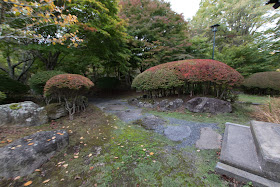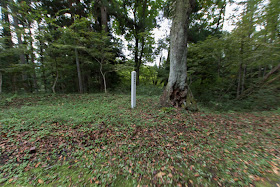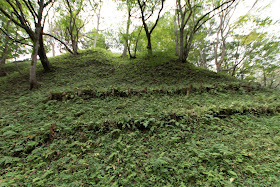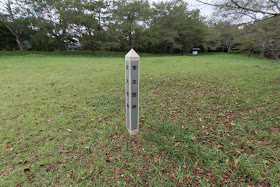Nabekura Castle
-Castle and folklore reflected tensioned border-
Overview
Name: Nabekura Castle (Nabekura-jo)
Alias: Tono-jo (Tono Castle)
Place: Tono cho, Tono city, Iwate
Location: 39.32622130770446, 141.52702100421027
Type: Mountain Castle
Built: 16th century?
Remaining remnants: Clay walls and dry moats
Title:
Type: Mountain Castle
Built: 16th century?
Remaining remnants: Clay walls and dry moats
Title:
Brief History
Nabekura castle (鍋倉城), also known as Tono castle (遠野城), is located at Nabekura-yama hill that is about 70 meter height from hillside at the south of current Tono city central. Nabekura-yama hill prolongs into the center of Tono town from backside mountains like a peninsular, and being connected to backside mountain by only narrow saddle point and surrounded by Rainai-gawa river as natural water moat, it is an ideal place to build a castle.
Tono area is a basin of 10 kilometer long square among Kitakami-Kochi mountains, being formed by Sarugaishi-gawa river and Hayase-gawa river. Due to limited mobility of residents prior to modern era and rich nature surrounding the basin, unique folklores weaved by human and nature has been flourished in this area. Later these folklores were introduced in the book “Tono Monogatari” (Tono stories) written by Kunio Yanagida, then Tono area is known as a village of folklore.
Origin of Asonuma clan
Precise year is unknown but Nabekura castle was built by local lord Asonuma clan in the latter half of 16th century. Asonuma clan was a descendant of Hidetsuna Fujiwara (891-958) and originally a local lord in Shimotsuke province (Tochigi prefecture). Asonuma clan served to Yoritomo Minamoto (1147-1199), the founder of Kamakura Shogunate, and contributed to the establishment of Shogunate.
After the fall of Oshu Fujiwara clan in 1189, Kamakura Shogunate gave the former territories of Oshu Fujiwara clan to its retainers. At this time Asonuma clan achieved Tono area, and at first Asonuma clan sent its magistrate to Tono area and indirectly governed it from original territory. But later Asonuma clan moved to Tono area and turned to local lord of the area.
At first Asonuma clan lived at Yokota castle (Iwate prefecture), that is built at gentle slope of Gomado-yama mountain at the north of Sarugaishi-gawa river. Yokota castle spreads over a plateau of 300 meter long and 100 meter wide being surrounded by creeks at both side, and separated by dry moat from backside height.
Conflict with surrounding lords
After the fall of Kamakura Shogunate, Asonuma clan once supported Akiie Kitabatake (1318-1338), the general commander of the South Court in Tohoku region and was approved as the lord of Tono area, but later turned to Muromachi Shogunate and survived as the retainer of Muromachi Shogunate and followed to Nanbu clan, a strong warlord in the north part of current Iwate prefecture.
In the former half of 15th century, Takenami clan which was the lord of Kesennuma area about 30 kilometers apart from Tono area intruded into Tono basin and attacked Yokota castle. Inferior Asonuma clan asked reinforcement army to Nanbu clan, then Moriyuki Nanbu (1359-1437), the leader of Nanbu clan, lead Nanbu army and headed toward Tono basin.
Nanbu army broke the army of Takenami clan near Yokota castle, then Takenami clan retreated from Tono basin. Next Nanbu army encircled Otsuchi castle (Iwate prefecture), a main base of Otsuchi clan which was originally a branch family of Asonuma clan but supported Takenami clan. But at the siege Moriyuki Nanbu died by stray arrow from the castle, then Nanbu army retreated from Otsuchi area.
Build of Nabekura castle
This battle was an ideal result for Asonuma clan, as the opponent of Asonuma clan was broken by Nanbu army and Asonuma clan itself avoided the reign of Nanbu clan due to the loss of its leader. Otsuchi clan again followed to Asonuma clan, and Asonuma clan grew into the mid size local lord that held Tono basin and coast area such as Otsuchi area and Kamaishi area.
In the latter half of 16th century, Nanbu clan again headed their army toward south. This time Asonuma clan tried to prevent the expansion of Nanbu clan as an independent local lord, in alliance with Shiba clan that was the lord of Kosuiji castle (Iwate prefecture) at the north of Tono area.
Around 1570, Asonuma clan built Nabekura castle and moved its main base from Yokota castle. It is said that Nabekura castle was at the side of Sarugaishi-gawa river and suffered the damage of flood, but it might be rather for the purpose of centralization of Asonuma clan to gather retainers around the castle and build a castle town, that was impossible at narrow Yokota castle.
Structure of Nabekura castle
Central area of the castle is an oblong shaped one of about 150 meter long and 50 meter wide at the top of the hill. There might be the hilltop residence of the lord, and main gate and backside gate were built at its east side and west side respectively. The main gate was decorated by stone wall and stones slightly remain around the gate. At the north of central area terraces used as the residence of retainers continues toward the hillside.
Secondary area is at the south of central area ahead of dry moat and now used as the ground of tombs. South edge of the castle is a weak point connected to backside mountain thus this part is securely protected by dry moats and shooting position. West line of central area and secondary area is protected by the line of corridor terrace and horizontal dry moat.
At the north east of central area, there is third area of 150 meter long and 50 meter wide now watching tower stands. The terrace at the below of third area now used as the ground of Nanbu Shrine was the main gate area, and the ground used by folklore museum was the place of hillside residence. Total size of the castle is about 500 meter long and 300 meter wide and a large size castle at the area.
Expulsion from Tono area and attempt of revenge
In 1590, Asonuma clan did not visit the headquarter of central ruler Hideyoshi Toyotomi (1537-1598) at Odawara campaign, thus was deprived the status of an independent lord and forced to the retainer of Nanbu clan. But Nanbu clan also tried to decrease the power of retainer and process centralization at their territory.
In 1600, Hironaga Asonuma (?-?), the leader of Asonuma clan, accompanied with Nanbu army which helped Mogami clan which was the lord of Dewa province (Yamagata prefecture). But on the absence of Hironaga, relatives and retainers of Asonuma clan rebelled against Hironaga, then Hironaga could not return to Nabekura castle and ran to Sumita area across the mountain, where was the territory of their relative Setamai Asonuma clan served to Masamune Date (1567-1636).
Asonuma clan had relationship with Date clan, and Nanbu clan feared the effect of Date clan thus expelled Asonuma clan in advance. In response to this, Masamune Date was a ambitions strong lord and aimed at the expansion toward Nanbu territory then supported Waga and Asonuma clan to recover their former territories from Nanbu clan under the influence of Date clan.
In 1601, Hironaga Asonuma intruded into Tono area three times under the support of Date clan to recover his territory. But these attempts of Asonuma clan all failed then Asonuma clan declined without returning the lord of Tono area. On the other hand, Nanbu clan purged the relatives of Asonuma clan who rebelled against Hironaga Asonuma, then turned Tono area to the direct territory of Nanbu clan.
Large fort toward Date clan
At this time Nanbu clan also suppressed the rebel of Waga clan at Hanamaki area, but was quite cautious for the situation of the southern border toward Date clan. Nanbu clan kept Hanamaki castle (Iwate prefecture) as a formal castle for the exception of one domain one castle rule, and also kept Nabekura castle as a fort.
The size of Hanamaki castle and Nabekura castle were quite large compared with the size of Morioka domain of Nanbu clan, and this shows the strong caution of Nanbu clan toward Date clan. In 1627, for the purpose of control of relative and security of the border, Nanbu clan transferred its relative Hachinohe clan from Nejo castle (Aomori prefecture) to Nabekura castle.
In 1642, both of Nanbu clan and Date clan finally agreed the border line under the coordination of Edo Shogunate, and mounds were built as the sign of the border for 130 kilometer long from inland area toward Pacific ocean. The border had stabilized but both domains built barriers especially at eastern half of the border and limited the mobility of residents.
Castle and folklore reflected tensioned border
The folklores of Tono area gathered in “Tono Monogatari” well showed the situation. The most famous tales are related with gods or elementals such as Zashikiwarashi (child gnome brings wealth to home), Kappa (water gnomes make mischiefs) or Oshirasama (god of agriculture or horse).
Second group of tales are about the border of the basin, in which there were mysterious facts or missing of the people in the mountains surrounding the basin. And some tales depicts the trip or trade with coast side area, but the opponents were wholly the territory of Nanbu clan and there was no topic of Date territory prior to Meiji revolution.
People were told not to cross the border of the basin in the form of the tales, both for the physical security and political safety. Hachinohe clan later changed their surname to Nanbu clan and reigned Tono area by the end of Edo era. At the time of Meiji revolution Nabekura castle was finally abolished.
Now no building remains but structure of the castle well remain on the mountain. Large terraces surrounded with sheer cliff, dry moats and clay walls protect important area of the castle shows Nabekura castle was a genuine fortress toward Date clan, in spite of one domain one castle rule. Residents of Toho area worshiped and feared the fictional spirits or gnomes, but lord of Tono area prepared for physical threat of Date clan.
Access
20 minutes drive from Tohoku Jidoshado Expressway Mizusawa interchange to parking of Tateyama Historical Park.




















































































































































































































































































No comments:
Post a Comment